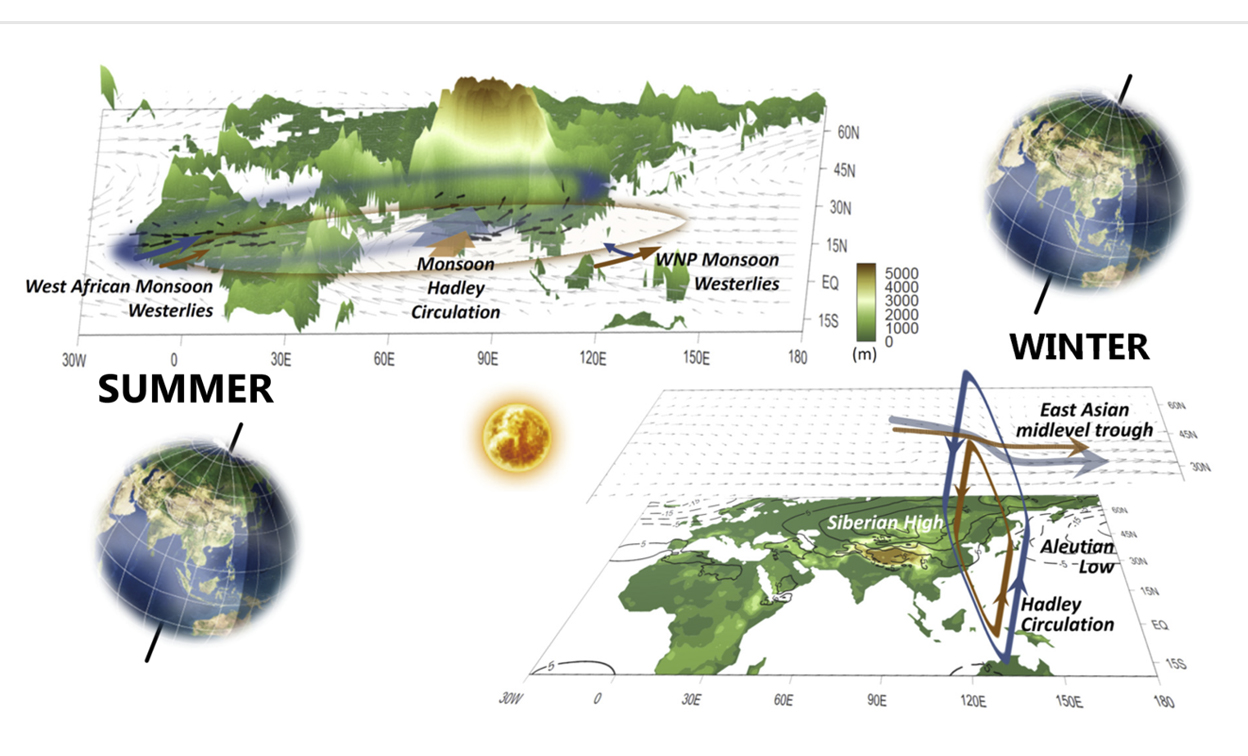


FIG: Schematic of obliquity-driven contrasts (shadings: topography, unit: m). In summer, in high obliquity (blue) compared with low obliquity (orange), the monsoons over West Africa, South Asia, and East Asia are stronger and can penetrate further northward, whereas the WNP monsoon trough is weaker and even disappears. In winter, the sea level pressure (contours in lower panel), the 500-hPa East Asian trough (vectors in upper panels), and the Hadley circulation across East Asia are weakened following a decrease in obliquity.
Obliquity, as a factor controlling seasonality, has been considered a modulator of paleomonsoon evolution. However, in contrast to the clearly identified contribution of precession, East Asian proxy records rarely provide a robust signal of obliquity. To explore the obliquity effect, climate simulations are conducted by fixing orbital parameters of extremely low and high obliquity. The major finding is that, the precipitation migration of continental summer monsoons (West Africa, South Asia, and East Asia) closely follows obliquity-driven meridional insolation changes, confirming the traditional paradigm of an obliquity–seasonality relationship. In contrast to high obliquity where the meridional expansion of precipitation can be clearly observed, precipitation (primarily associated with the Afro–Asia summer monsoons) in low obliquity is confined to the subtropical area, closely following obliquity-driven changes in monsoonal circulation. The stage-wise seasonal evolution of East Asian precipitation is no longer visible when obliquity is extremely low.
In summer, convective activity is enhanced over Southeast Asia–western North Pacific (WNP), unlike the weakened and position-limited monsoons over South Asia, East Asia, and West Africa in low compared with high obliquity. In contrast to high obliquity where monsoons are continentally confined, monsoons with subtropical and oceanic origin are visible in low obliquity. Regarding the present-day transition of monsoon phase in midsummer, which involves circulation changes on a large scale (Afro–Asia–WNP) and intrinsic regional dynamics over East Asia–WNP, obliquity has substantial effects in terms of driving the dramatic subseasonal transition. In winter, the strength of synoptic scale (the midlevel trough, Siberian high, and Aleutian low over and around East Asia) and larger scale (midlatitude westerly jet stream and Hadley circulation) circulation is coincidently weaker in low compared with high obliquity. Notably, the obliquity-driven changes over East Asia–WNP are sensitive to greenhouse gases (GHG) concentrations. Some major obliquity-driven changes weaken and even disappear when GHG concentrations increase.
Key points
More information